

To Improve Education – Focus on Pedagogy Not Technology. It’s an exciting time for technology in education.

Global tech companies such as Google, Amazon and Microsoft are promoting adaptive teaching systems to give each student a personal tutor that responds to their personal needs and ability. Machine learning systems can analyze data from online learning platforms to predict a student’s future performance. Virtual reality offers alternative worlds of historical re-enactment and scientific wonder.
Even drones have been recruited to the teaching of geography. But technology alone won’t solve the deep problems of education. After 40 years of technologies for learning – educational television, language labs, classroom response systems, programmable robots – the only specifically educational technology that is widespread in schools is the electronic whiteboard.
Understanding The Science Of Learning And Our Role In The Process. It is a blessing and a curse.

Over the past 10-20 years, there have been numerous books, articles, and videos centered around the idea of cognitive science—or the science of how we learn. How To Not Quit Teaching. Four of every ten new teachers leave the profession within five years. That is a staggering number. It’s made all the more alarming given that teacher shortages in the US are expected to exceed 300,000 by 2020. Although low starting pay, large class sizes, and lack of autonomy are certainly factors . . . How to Improve Your Questioning Techniques. The 19 Best Teacher Websites That Help You Be Awesome for Kids. It’s easy to get overwhelmed with the sheer volume of teacher websites and resources on the internet.
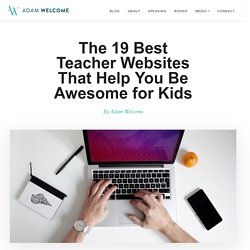
It’s a bit like drinking from a firehose. That’s why, in this post, I’ve compiled some of my favorite teacher websites into a “water fountain” that’s much easier to handle. Keep reading to see what they are. My Favorite Blogs and Websites for Teachers 1. Using Videos in the Classroom to Amplify Learning. Teachers are always striving to show more and tell less when introducing students to new information, concepts, and skills.
Education researcher Pauline Gibbons tells us, “Rather than trying to simplify information, amplifying the curriculum means finding as many ways as possible to make key information comprehensible.” What Are the 13 Types of Literacy? When we think of literacy, we usually think of the ability to read and write.
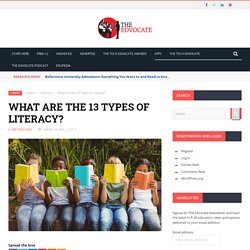
However, the understanding of literacy that we possess is often curtailed by our educational experiences. Those of us in the field of education know that there are numerous types of literacy, all of which help us navigate life and fully engage in our d society. In this short piece, I will briefly define each of the 13 types of literacy, and I hope to cover each one in an upcoming article series. Digital Literacy- By this definition, encompasses a wide range of skills, all of which are necessary to succeed in an increasingly digital world. 7 Ways to Spark Engagement. Student engagement is the Mega Millions of education: When you hear about it, it seems so easy to win—and then you read about the odds. The good news is that there are effective strategies for boosting student engagement, and they’re considerably more likely to pay off than playing the lottery. A growing body of research in education and the social sciences suggests that students’ curiosity can be stimulated in ways that strengthen their connectedness to lessons, interactions with each other, and willingness to commit to learning goals.
There are simple techniques that teachers can use during a lesson to boost curiosity, and thus engagement, among students—especially older ones, who are at greater risk for losing interest. Boosting Student Engagement 1. 10 scaffolding strategies to help all students reach their goals. Scaffolding strategies help get the job done.

Imagine being asked to scale a twenty-foot wall. Your only directions are to get to the top. You might be one of the few people who can climb up the wall effortlessly, but in reality, you may need a little help. Differentiating Instruction: It’s Not as Hard as You Think. 5 Edtech Trends That are Influencing Student Engagement. In the not-so-distant past, student apathy seemed to be at an all-time high.
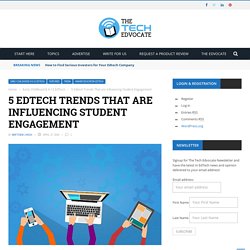
Children would fill classroom seats but their minds weren’t engaged in the material, even during the lesson itself. When they left their desk at the end of the hour, they hardly ever considered the material again in their daily life. The paradigm is shifting as student engagement rises alongside the introduction of edtech into the modern, blended classroom setting. Edutopia. ‘Mindfulness’ defuses stress in classrooms and teaching. The bell rings at 7:40 a.m. in a public high school in New Jersey, and science teacher Laura McCluskey begins the first of what she calls “five shows a day.”
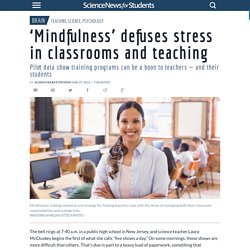
On some mornings, those shows are more difficult than others. That’s due in part to a heavy load of paperwork, something that consumes large amounts of her time and energy. Then there are the other, outside events that happen in McCluskey’s life. Edutopia. Icebreakers that Rock. Dogfooding: Do You Do Your Own Assignments? 11 ways to bring out your students' super powers. Helping students find their strengths — their “super powers” — can change them forever.

Use some of these strategies to see big changes! (Photo via Nili Bartley / Take It to the Classroom) Want to stop bullying, improve the classroom and school climate and improve achievement all at the same time? Help your students become superheroes. Using the SuperYou FUNdation curriculum, teachers are helping students empower themselves and become the best versions of themselves. You can see these results in your own classroom or school, too, by requesting the SuperYou curriculum or by using the strategies mentioned below. Two years ago, Lourds Lane, the book, music, and lyrics writer of the Broadway-bound musical “Chix 6,” volunteered at an inner-city school in Harlem on her days off from the stage. The SuperYou curriculum was born. Edutopia. Edutopia. Our students are reading all day long—text messages on their phones, emailed directions about homework, apps from advertisers. They read what interests them and what helps make their world a more real, relevant, and relatable place to live.
And we can tap into their interests to embed speaking, listening, reading, and writing in classes to help achieve content objectives. Keep It Real. Why Flipped Learning Is Still Going Strong 10 Years Later. Ten years ago two Colorado chemistry teachers unleashed a brash concept on a K-12 landscape where few questioned the age-old formula of lecture, homework, assess, repeat.
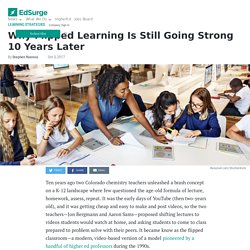
It was the early days of YouTube (then two-years old), and it was getting cheap and easy to make and post videos, so the two teachers—Jon Bergmann and Aaron Sams—proposed shifting lectures to videos students would watch at home, and asking students to come to class prepared to problem solve with their peers. It became know as the flipped classroom—a modern, video-based version of a model pioneered by a handful of higher ed professors during the 1990s. A few years later, the concept lit up like rocket fuel thanks in part to the catchy name, along with fast-growing home internet connectivity and a shout-out in Sal Khan’s popular TED Talk.
Or maybe it stemmed from the fact that anyone could get the gist of the teaching idea in the time it takes to rattle off a sound bite. 7 Ways to Develop Grit in Your Kids. Making the Most of a 90-Minute Class. "Kids Can't Learn From Teachers They Don't Like" 1 minute read ‘Kids Can’t Learn From Teachers They Don’t Like’ by TeachThought Staff.

The Tech Edvocate’s List of 99 Curriculum and Instruction Apps, Tools and Resources - The Tech Edvocate. Why Students Forget—and What You Can Do About It. Teachers have long known that rote memorization can lead to a superficial grasp of material that is quickly forgotten. But new research in the field of neuroscience is starting to shed light on the ways that brains are wired to forget—highlighting the importance of strategies to retain knowledge and make learning stick.
In a recent article published in the journal Neuron, neurobiologists Blake Richards and Paul Frankland challenge the predominant view of memory, which holds that forgetting is a process of loss—the gradual washing away of critical information despite our best efforts to retain it. According to Richards and Frankland, the goal of memory is not just to store information accurately but to “optimize decision-making” in chaotic, quickly changing environments. In this model of cognition, forgetting is an evolutionary strategy, a purposeful process that runs in the background of memory, evaluating and discarding information that doesn’t promote the survival of the species. Teaching & Assessing Soft Skills. The career landscape is changing dramatically. The Bureau of Labor Statistics states that the average worker currently holds ten different jobs before the age of forty.
How Your Nonverbals Impact Your Teaching. Structure Learning With Essential Questions Lesson Planning Tips. 6 Completed Lesson And Unit Plans. Recently, I wrote a blog about 5 ways that we can learn through writing lesson plans. 10 Great Lesson Planning Templates And Resources. 10 Dos & Don'ts For Teaching Vocabulary In Any Content Area. Is Personalized Learning the Future of Education – The Tech Edvocate. Classroom Management Strategy: Setting The Tone. How To Build A Culture Of Learning. 5 Personalized Learning Strategies That Teachers Need to Know - The Tech Edvocate. 22 Powerful Closure Activities. What Does Student Engagement Look Like?
The engaged student vs. the compliant student. The engaged student knows exactly why they are doing what they are doing while the compliant student is unable to connect the learning to anything meaningful. The engaged student is asking questions while the compliant student is simply receiving instructions and direction from the teacher. How To Ensure Students Are Actively Engaged and Not Just Compliant.
Educational Technology and Mobile Learning: The Do’s and Don’ts of Giving an Effective Presentation. Why Understanding These Four Types of Mistakes Can Help Us Learn. Enliven Class Discussions With Gallery Walks. Untitled. How to Approach Your Teaching Like a Master Chef. Listen to my interview with John Stevens and Matt Vaudrey, or read a full transcript here. We Grow by Embracing Our Teaching Mistakes. Questions Before Answers: What Drives a Great Lesson? Six Ways to Successfully Build Relationships with Your Students.
Edutopia. Six Ways to Successfully Build Relationships with Your Students. Edutopia. Professional learning communities bring benefits for teachers, students. Sir Ken Robinson: Creativity Is In Everything, Especially Teaching. 5 Engaging Uses for Letters in Your Classroom. How To Help Every Child Fulfil Their Potential. 10 things students experience every day at school that we educators tend to forget about... What the Heck is Inquiry-Based Learning? 4 Approaches to Building Positive Community in Any Classroom. Education Week. Encourage critical thinking by turning your class into a Socratic Seminar. Open Space Technology: Decision by Inclusion.
Why Teachers Should Experiment and Fail. What Doesn't Work When Evaluating Teachers. Learn Teach Lead Radio. A 4-Part System for Getting to Know Your Students. Rewarding behavior is key to parenting teens, study suggests. Growth Mindset Lesson Resources. Three Effective Techniques for Brainstorming Ideas. A Collection of Resources for Teaching Social Justice. .@SirKenRobinson #creativeschools #education #teaching #learning #creativity #school #students thx @ColinMc1ntosh. 5 Ways to Help Your Students Become Better Questioners. 10 Things About Childhood Trauma Every Teacher Needs to Know. SXSWedu’s Opening Keynote, Temple Grandin, Revisits ‘Learning Styles’ Nine Things Educators Need to Know About the Brain. A doctor’s plea: Restore recess in metro Atlanta schools. The Jigsaw Method.
How Guessing Games Help Kids Solve Math Problems. How Parents and Teachers Can Work Together For Powerful Learning Outcomes. 10 Solutions for Students Who Fidget in the Classroom. Children today are suffering a severe deficit of play. Video and Professional Development: The Power of Observation. 'Energizers' activate Mendota Heights middle school classrooms. COMICS IN THE CLASSROOM: How one Wissahickon teacher uses comic books to connect with his students - Ambler Gazette. Using the Rule of Three for Learning. Differentiated Instruction: A Primer. It's time to take a long, hard look at the critical role of #recess in our schools. What local and global problems can our students solve? How can they make the world a better place? #edchat. Getting Smart on Teachers as Collaborative Curriculum Designers. To Help Students Learn, Engage the Emotions. A Nobel Laureate's Education Plea: Revolutionize Teaching : NPR Ed.
When Was the Last Time You Wrote a Positive Note Home to Parents? Five qualities of transformative VLCs. How to Get Past Negativity Bias in Order to Hardwire Positive Experiences. How to Stop Yelling at Your Students. Virtual Classrooms: A Vision of the Future of Teacher Training. Waiting is the Hardest (and Best) Part. Report: Teacher Prep Reform Gets It Way Wrong. Panel: Ditch Grades Now, Focus on Student Learning. How To Get Students Working Effectively In Groups. “Children, be quiet and watch your lesson” 5 features of poor teacher education.